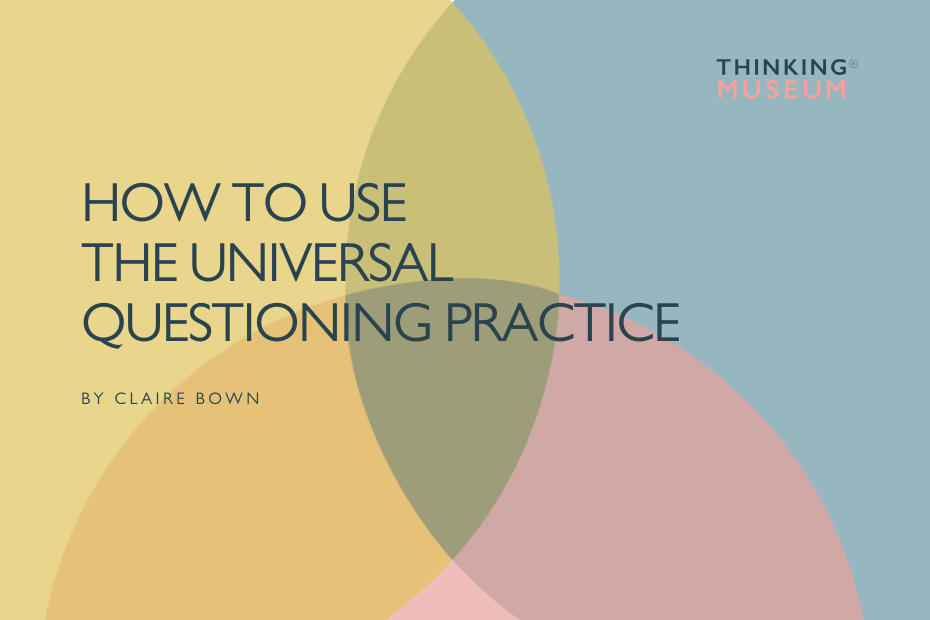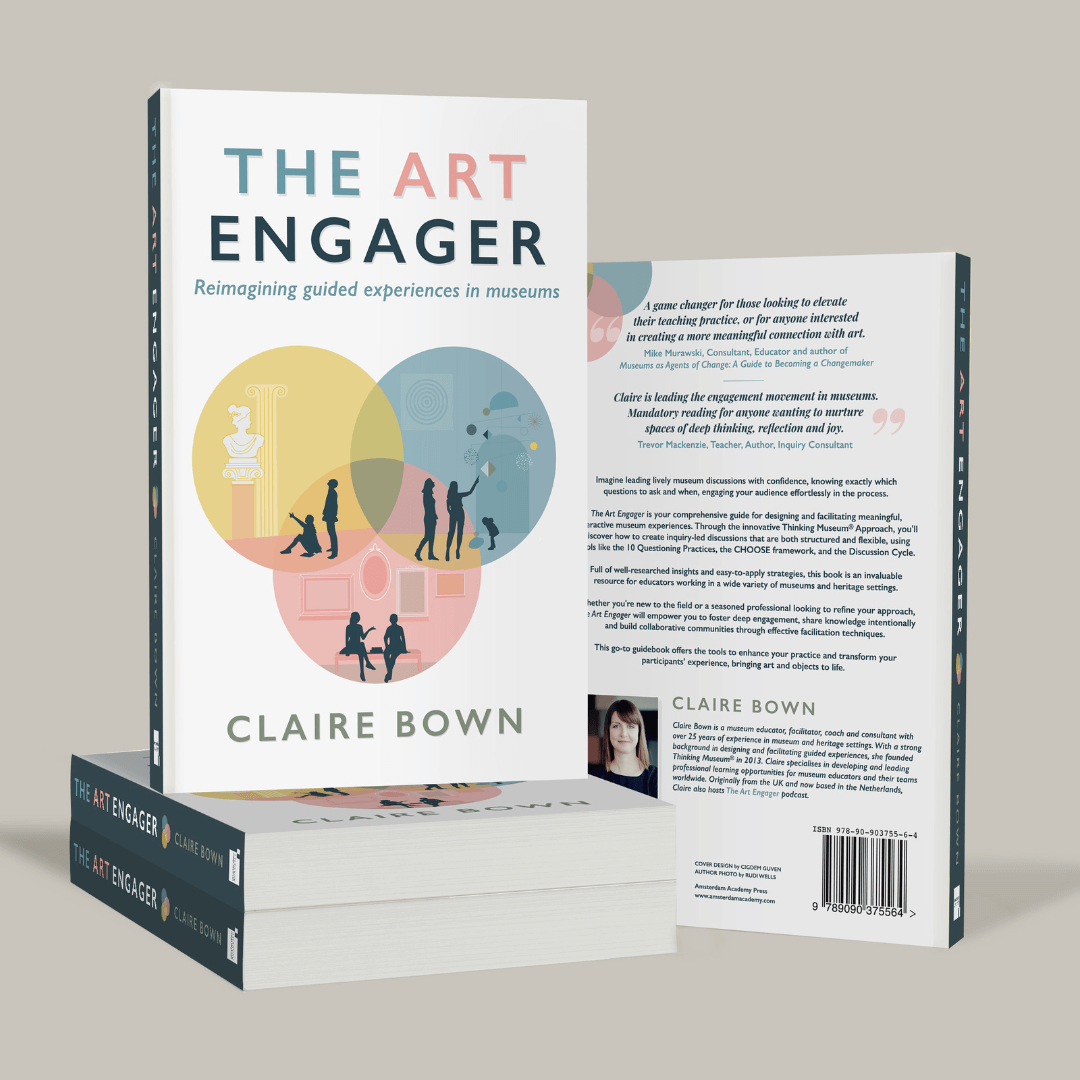As museum educators, we’re always seeking new ways to create more engaging, meaningful experiences for the participants in our programmes.
This article dives into one of the core Questioning Practices in the Thinking Museum® Approach – The Universal – a versatile framework that can transform how we facilitate discussions around art and cultural objects and connect with audiences.
For more on how The Universal Questioning Practice can improve your museum programmes, listen to the companion episode on The Art Engager podcast, where host Claire Bown explores these ideas further.
What are Questioning Practices?
A Questioning Practice (QP) is a structured set of questions or prompts designed to guide inquiry, stimulate critical thinking, and facilitate learning in museum and gallery environments. These practices are crafted to support meaningful engagement in museums and galleries, where participants explore art, objects, or ideas.
Questioning Practices help educators lead discussions that spark curiosity, foster dialogue, and build deeper connections with artworks, objects, and ideas.
Unlike standard questioning techniques, frameworks or protocols, Questioning Practices are flexible, adaptable, and personalised to the specific needs of each group or session. They allow educators to bring their own unique style to every interaction. (For a deep dive on QPs, see here)
What is The Universal Questioning Practice?
The Universal Questioning Practice is one of 10 core Questioning Practices introduced in my book, The Art Engager: Reimagining Guided Experiences in Museums.
The Universal is an all-purpose and versatile Questioning Practice that can be applied to all types of art and objects, across any museum setting.
It consists of four foundational questions that guide discussions and inquiry:
LOOK: What do you notice?
INQUIRE: What questions come to mind?
INTERPRET: What might this be about?
REFLECT: What insights did you gain?
The Universal QP evolved from my research into questioning strategies during my master’s thesis. Through studying various questioning frameworks—both within and beyond museums—I found that the components of a successful universal framework follow a structured progression: observation, inquiry, interpretation, and reflection.
The Universal echoes this structure of a well-rounded discussion that I noted was common to the questioning frameworks I explored. The 4 steps in The Universal enhance observation skills, encourage critical thinking, facilitate interpretation and promote reflection. From my experience facilitating art and object inquiries using The Universal, it’s the combination of these 4 steps together that creates the most engaging and thought-provoking discussions.
How to use The Universal
This Questioning Practice is intended to be used universally, with all types of groups, and with all types of artworks and objects. It can be used with a huge variety of materials – I’ve used The Universal with paintings, sculpture, historical, design and everyday objects, out and about in nature and with buildings, to name a few examples. It works as well in art museums as it does in historical, ethnographical, science museums and historic houses. It is adaptable, easy to use and naturally leads to open-ended inquiry amongst all types of participant groups. It can be applied in a variety of different situations, circumstances and environments.
The 4 simple stages (Look-Question-Interpret-Reflect) of The Universal guide and focus conversations around art and objects seamlessly. Instead of feeling stuck in a programme and wondering what question to ask next, you can lean on the logical structure of The Universal to support you. As this is a core Questioning Practice and the first one you should get to know, here’s an in-depth look at how to use it.
The 4 stages
Look
Begin by allowing time for participants to observe the artwork or object in detail. Then, ask the simple question: “What do you notice?” This foundational step encourages full description and avoids jumping to conclusions.
Question
Building on their observations, prompt participants with the question: “What questions come to mind?” This taps into their natural curiosity and opens up new lines of inquiry.
Interpret
Ask the broad, open-ended question: “What might this be about?” This allows for multiple perspectives – thematic, symbolic, personal, etc. – to emerge.
Reflect
Finally, ask participants: “What insights did you gain?” This consolidates the experience, promotes metacognition, and helps visitors articulate their learning journey.
Tips for using The Universal
Mastering the Basics First: Start by familiarising yourself with the Universal Questioning Practice as it is written before exploring variations or trying out other Questioning Practices. Get comfortable with the flow and rhythm of the four stages.
Try it with a Variety of Materials: The Universal is designed to be adaptable to all types of artworks, objects, and museum settings. Experiment using it with paintings, sculptures, historical artefacts, natural phenomena, and more to get a feel for its versatility.
Engage Different Audience Groups: The Universal works equally well with students, adults, and other visitor groups. Try it out in a range of contexts to see how it resonates across diverse audiences.
Reflect and Refine Your Approach: After each time using the Universal, take time to actively reflect on the experience. What worked well? What could be improved? Use these insights to fine-tune your facilitation and make the practice your own.
Embrace it as a “Practice”: Rather than viewing the Universal as a rigid exercise, approach it as a flexible, iterative “practice.” After several sessions, it will start to feel natural, fluid and easy to use. The aim is to ‘internalise’ this core QP as part of the invisible infrastructure of your discussions. Over time you will naturally make it your own, while also staying true to its values and principles. Once this happens, you can then start to add new Questioning Practices to your repertoire, to supplement The Universal.
Conclusion
So, let’s summarise what we’ve covered today. We looked at The Universal, a core Questioning Practice with four simple steps:
- Observation – What do you notice?
- Inquiry – What questions come to mind?
- Interpretation – What might this be about?
- Reflection – What insights did you gain?
This practice guides meaningful conversations and can be adapted for any artwork or object. Start with The Universal, get comfortable with it, and then explore other Questioning Practices to enhance your discussions.Thanks for listening! Don’t forget to check out The Art Engager on my website and pick up your copy wherever books are sold.
The Art Engager: Reimagining Guided Experiences in Museums
Whether you’re new to the field or a seasoned museum educator looking to refine your approach, The Art Engager is your go-to guidebook for creating the ultimate visitor experience.
Full of well-researched insights and easy-to-apply strategies, this book is an invaluable resource for educators working in a wide variety of museums and heritage settings.

